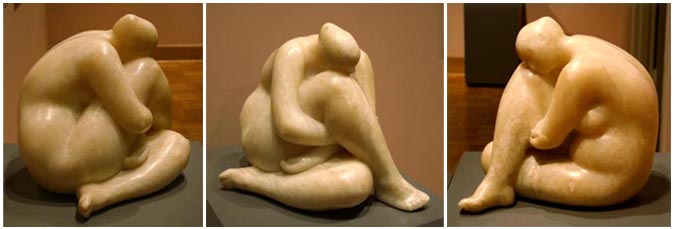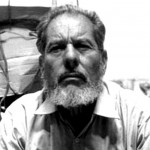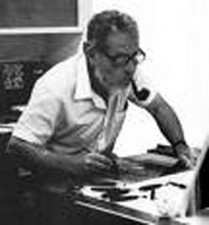
Francisco Zúñiga
Costa Rican, 1912-1998 (active Mexico)
Desnudo agachado (Bent Nude), 1969
onyx
16 ½ x 14 ¼ x 20 ¼ in.
SBMA, Gift of Mrs. Barbara Storke
1975.32.1

Undated photo of Zuniga
"I wanted sculpture to be sculpture for itself alone. I was formed in a time when sculpture tended to be functional. It was for architecture, for adorning walls. I worked twenty years for the government, making monumental sculptures you can see all about the city. Then one day I asked myself, isn't sculpture valuable in itself? Is it not autonomous? Why must it be bound to a space? So, I thought, I am going to make a woman, vertical. Standing alone. The problem of verticality is not an easy one. You see standing figures everywhere, doing this, or this, dancing, but not just standing. So I began making a standing woman, then I made two, or three. I made a group, standing--just standing--because my sculpture is very severe. But look around, you see them standing, or sitting. And then I made some walking. Now the problem was to make them slow. These standing women, I made them move, and walk. Some going here, some there, as they do in the markets, the native markets. A woman, carrying her things. Just go to Oaxaca and you will see a marvel of movement. Juchitán, Oaxaca, Mérida, Yucatán. That is my inspiration. I have never wanted to create sculpture that is merely intellectual." . . . .
Francisco Zúñiga
Translated from Margaret Sayers Peden,"Francisco Zúñiga," Out of the Volcano, Portraits of Contemporary Mexican Artists, Smithsonisn Institution Press, Washington and London, 1991, pp. 29-31.
RESEARCH PAPER
The common, indigenous people of Mexico and their heroic endurance are the essence and inspiration for Francisco Zuniga’s art. His themes consist almost exclusively of female human figures, which present women as dignified, powerful, timeless, and stoic figures. Zuniga described his work as “a continuous representation of femininity.” Zuniga’s women evoke “ancient goddesses disguised in the contemplative situations of daily life and motherhood” (Doubletake Gallery). Through line, mass and volume, Francisco Zuniga’s Bent Nude celebrates the archetypal woman of southeastern Mexico, but on a still larger scale it embodies the spirit of all women. Zuniga’s work is truly universal because it transcends the barriers of time, status, and geography.
Although Zuniga was born in San Jose, Costa Rica, he has always been considered a Mexican artist; he spent most of his life in Mexico and his connections were to the Mexican masters of the twentieth century—Diego Rivera, Jose Clemente Orozco, David Siqueiros, and Jose Luis Cuevas. Born in 1912, Zuniga began helping in his father’s artisan workshop when he was thirteen. Here he was exposed to the woodcarvings of religious figures his father sculpted and sold to local churches. His father was a major influence on his art, particularly in terms of the technical aspects of sculpture. Zuniga drew, painted, and worked in stone, with his sisters and his mother as his models. During this time Zuniga stated: “I was avid to know and to learn, to keep abreast of artistic movements. I studied the impressionists, Gauguin, the cubists, the expressionists.” Zuniga attended the School of Fine Arts from 1927 to 1928 where he began painting with oils, which later served as a complement to sculpting. An important step toward independence from his father’s studio came when he was eighteen; he produced his first sculpture in stone, Maternity, a depiction of a mother tenderly holding her newborn, carved out of a massive, rough stone.
At the age of twenty-three, Zuniga left his home and country and traveled through Mexico to his final destination: Mexico City. This journey proved to be significant in terms of the subjects he would later sculpt. In his travels, he became especially intrigued with the indigenous features in the faces of the native people in rural areas. “This visual study became the basis for the social iconography in the numerous public monuments he ultimately created throughout the country” (Sutro, p. 645). Mexico City in the 1930’s was one of the major art centers of the Americas. It “witnessed and participated in many of the frenzied and controversial art movements which reflected the political and intellectual climate of the first three decades of the twentieth century” (Neito). Zuniga became a student at the School of Direct Carving. He studied there for two years, and then later became a professor at the school where he taught for thirty years: the name of the school is now the School of Painting and Sculpture. Zuniga read art books and magazines profusely. He was very familiar with Picasso and Cezanne, and many books spoke of the influence of Black African art on artists such as Matisse. To paraphrase Zuniga, “I thought I could do the same thing with folk art and with the influence of pre-Columbian art, of course I was not the first to discover this, I tried to do in sculpture what was being done in painting.” A book that was significant to Zuniga at this time was The Rediscovery of America, written by Waldo Frank. It was about the influence of the pre-Columbians on painting in Mexico. “I was very affected by this book, and it made me think we should go in the direction of an art with Latin American roots in our work” (Reich, p. 9). To support himself, in the early years in Mexico, he worked in sculptors’ workshops as an assistant where he became quite familiar with the lost wax process, which one can see he perfected in his massive female figures cast in bronze.
In the early 1930’s, soon after arriving in Mexico, Zuniga met the painter Manuel Rodriguez Lorzano who helped to motivate Zuniga’s concept of form. Lorzano was more “interested in my drawing than my sculptures, and for at least two years he influenced my painting” (Reich, p. 17). Other important influences were the works of contemporary sculptors: Rodin, Maillol, Brancusi, and Moore, whose work, like Zuniga’s, was primarily based on the human body. In studying Rodin, Zuniga might have noted that the displacement of axis could create a dynamic tension. From the ancient art of the Cyclades via Brancusi, the perfect ovoid shape became a hallmark of Zuniga’s work and is especially apparent in Bent Nude. The robust, heroic women of Maillol are evident in many of Zuniga’s sculptures. Like Maillol, Zuniga admired the Egyptians: “to me they represent the absolute mastery of material” (Zuniga, in Chumacero, p. 21). One can see Moore’s influence in Zuniga’s use of convexities and concavities in Bent Nude. While there may be similarities to the above, Zuniga was markedly different. His sculptures are poignant; they are presented without smiles or tears, as impassive, resolute in the hardships of daily life. Their very massive, sturdy forms draw the viewer for a quiet, closer look.
In addition to the activity of the contemporary art world in the city, the early years in Mexico City had a deep and lasting impact on Zuniga for other reasons: frequent visits to the Museum of Archaeology. Here he discovered the magic of pre-Hispanic art. In his own words: “The jumbled collection of pre-Hispanic sculptures revealed to us in its somber halls a magic world, the myth of life and death in aggressive, rounded figures with a heaviness. I wrote down on one occasion, ‘This will always be a necessary lesson and quest. But it is not a matter of a return to the past, nor an archaic repetition of decoration and symbols, but rather a contact, a well-spring of tradition and its dramatic interpretation.’” One can clearly see in Zuniga’s work just how significant were these hours spent in the Museum of Archaeology. What was essential to Zuniga was investigating the cultural forms, which make up the Latin American identity.
It is clear that Zuniga’s work has roots in both ancient and modern art. Of his style Zuniga states, “I do not seek mannerisms, or technical perfection; my style is my own real self.” After twenty years of creating monumental public sculptures, Zuniga indeed found his own unique mode of expression in the 1960’s: the single “individualistic form or the eternal female earth force personified in Indian women” (Sutro, p.646). In Bent Nude one can see the fulfillment of Zuniga’s words; the lines are smooth and melodic rather than anatomically precise. The female figure, Bent Nude seems to be part of the earth itself with its weighty gravity. Zuniga said that instead of “fabricating pieces that proceed from the surface inwards,” he prefers to have his figures do the opposite, which is exactly what the closed form of Bent Nude does. She seems born with her own emotional center, so much so, that her very being seems to be folded into herself. She is rounded in heaviness. Is it the weight of sorrow? Or is she in a state of peaceful resignation? The elongated, curved spine (from the hips to the dropped head) strongly suggests the emotional center is indeed, within; there is a silent intensity which emanates outward. Zuniga stated: “I begin with an emotion, an attitude, a movement caught by chance, a woman wrapped in thought…” Bent Nude seems to have been created with those very words in mind.
When one observes Bent Nude from various angles, the ovoid shape is repeated from the head, chin, bent knees, buttocks, even the breast, where the thigh eclipses part of the oval. The ovoid shape encompasses the quintessential Zuniga with his focus on the female form in all its glory: standing squarely with feet firmly planted on the earth, squatting in the age-old crouch women have assumed in their labors, leaning, reclining, or cradling a child in protective arms. Ovoid is an oval shape in three dimensions. In every culture, the ovoid shape is the symbol of life: it evokes associations with an egg, the symbol for the potentialities of future life and growth. For example, in Tibetan art, the ovoid symbolizes the universe, the womb, the cosmic egg, new life, understanding, and female or yin energy.
Onyx is the perfect medium as a metaphor for life with its egg-like color, translucent in places and opaque in others, delicate vein-like lines characteristic of onyx flow throughout the piece. Zuniga enjoyed working in stone and onyx, he appreciated the continuity of their surfaces, took pleasure in polishing the various shapes and contours. Bent Nude communicates something deep and quiet, which is different for every viewer. In the mysterious form, the viewer decides whether she is in a state of serene detachment, passive resignation, or self-sufficient repose. There is calmness; there is passive power within the form. One wants to reach out and touch the smooth surface of the figure to console or perhaps to be consoled. Zuniga wanted to achieve a “richness of essential and significant forms,” he strove to transmit the “noble exasperations and exhilarations found in the dignity of the common man.” Bent Nude is a triumph to that end.
Chronology: Francisco Zuniga 1912-1998
1912
December 27, born in Guadalupe, San Jose, Costa Rica. Son of religious sculptor Manuel Maria Zuniga and Maria Chavarria.
1935
Works on the “Maternidad” (Maternity), his most important sculpture from Costa Rica.
1936
Travels to Mexico through Guatemala. He decides to live in Mexico City.
1949
Included in the book Forty-Five Mexican Artists by Virginia Stewart, published by Stanford University Press.
1957
Participates at the annual sculpture show in Mexico City obtaining the acquisition prize with his piece “Hamaca”, carved in Xaltocan stone.
1969
Misrachi Editions publish the first monograph about his work. First large retrospective of his personal work at the Modern Art Museum, Mexico City.
1973
Works in his first lithographs in San Francisco, California with Editions Press in the project: Mexican Masters Suite, including works by Cuevas, Tamayo, and Siqueiros.
1980
Tucson University Press publishes the book, Francisco Zuniga, Sculptor: Conversations and Interpretations, by Sheldon Reich. Misrachi Editions in Mexico publish a complete monograph about his work.
1984
Participates at the Third Sculpture Biennial in Japan and obtains the “Kotaro Takamura prize”, with his work: “Group in front of the Sea”.
1986
Becomes a Mexican citizen. An important individual exhibition takes place at the Musee de l’Orangerie and Jardin des Tuilleries, Paris, France.
1987
Becomes a member of the Academy of Arts, Mexico.
1990
Blind, he continues working in terra cotta at his studio in Mexico City.
1993
Stops working.
1994
An important exhibition takes place at the Palace of Fine Arts, Mexico City.
1998
Dies on August 9, at his studio in Mexico City.
Prepared for the Santa Barbara Museum of Art Docent Council by Jane Tucker, March 6, 2006
Bibliography: Francisco Zuniga
Books and Journals
Chumacero, Ali. Zuniga. (Including autobiographical notes by Francisco Zuniga), Galeria
de Arte Misrachi, Mexico, 1969. ***
Reich, Sheldon. Francisco Zuniga, Sculptor: Conversations and Interpretations, University of Arizona Press, 1980. ***
Sutro, Martha. St. James Guide to Hispanic Artists, Detroit: Gale Group, 2002. **
Catalogues from Exhibitions:
Gheno, Dan. “Strength of Character,” Santa Barbara News and Review, Circa 1978.
Mills, Paul, C. “Francisco Zuniga: Sculpture and Drawing,” (Courtesy of the Tasenda Gallery), Santa Barbara Museum of Art, June 30 – July 30, 1978.
Websites:
Doubletake Gallery, Burnsville, Minnesota.
Margarita Nieto. From Jack Rutberg Fine Arts, West Hollywood. Sept. 21-- Dec.1, 2001.
The Official Francisco Zuniga Website.
The Adani Gallery.
< http://wwwadanigallery.com/Zuniga/aboutzuniga.html> (January 1, 2006).
Zone, Ray. From Jack Rutberg Fine Arts, West Hollywood. January 16- March 13, 2004.
“Biography from Butler Institute of American Art,”
*** denotes excellent source ** Very helpful general information

Zuniga at work in his studio.
SBMA CURATORIAL LABELS
Francisco Zúñiga was born in San Jose, Costa Rica, but he has always been considered a Mexican artist. At the age of thirteen, he helped carve wooden religious figures known as santos in his father’s workshop in Costa Rica. Ten years later he moved to Mexico, drawn by its flourishing post-Revolutionary art scene and its rich pre-Columbian sculptural tradition. Through visits to museums in Mexico City, Zúñiga gained an admiration for the sculpture of Southeast Mexico and Costa Rica, particularly that of the Maya and Chorotega cultures, which provided a basis for his sculptural explorations.
In 1959, Zúñiga began to incorporate influences from British sculptor Henry Moore, who himself was interested in pre- Columbian sculpture. He shared Moore’s preoccupation with the solid, monumental stone sculptures of reclining human figures found in Maya temples. Desnudo agachado highlights the artist’s interest in volume and space, with its translucent onyx polished to convey a sense of continuity.
SBMA title card information 2013
At the age of 13 Francisco Zúñiga began to carve wooden religious figures in his father’s Costa Rican workshop. Ten years later he moved to Mexico, drawn there by both its flourishing post-Revolutionary art scene and its rich pre-Columbian past. Through visits to museums in Mexico City, Zúñiga gained an admiration for the sculpture of Southeast Mexico and Costa Rica, particularly that of the Chorotega, Huetar, and Maya cultures, which provided a basis for his sculptural explorations including Desnudo agachado.
SBMA Wall Text 2000
